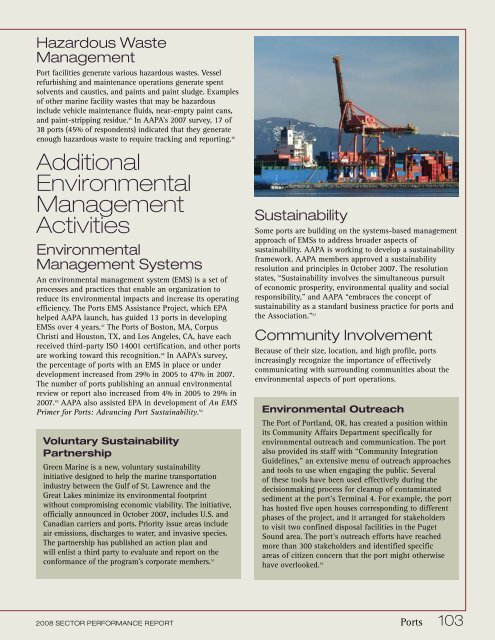2008 Sector Performance Report - US Environmental Protection ...
2008 Sector Performance Report - US Environmental Protection ...
2008 Sector Performance Report - US Environmental Protection ...
You also want an ePaper? Increase the reach of your titles
YUMPU automatically turns print PDFs into web optimized ePapers that Google loves.
Hazardous Waste<br />
Management<br />
Port facilities generate various hazardous wastes. Vessel<br />
refurbishing and maintenance operations generate spent<br />
solvents and caustics, and paints and paint sludge. Examples<br />
of other marine facility wastes that may be hazardous<br />
include vehicle maintenance fluids, near-empty paint cans,<br />
and paint-stripping residue. 45 In AAPA’s 2007 survey, 17 of<br />
38 ports (45% of respondents) indicated that they generate<br />
enough hazardous waste to require tracking and reporting. 46<br />
Additional<br />
<strong>Environmental</strong><br />
Management<br />
Activities<br />
<strong>Environmental</strong><br />
Management Systems<br />
An environmental management system (EMS) is a set of<br />
processes and practices that enable an organization to<br />
reduce its environmental impacts and increase its operating<br />
efficiency. The Ports EMS Assistance Project, which EPA<br />
helped AAPA launch, has guided 13 ports in developing<br />
EMSs over 4 years. 47 The Ports of Boston, MA, Corpus<br />
Christi and Houston, TX, and Los Angeles, CA, have each<br />
received third-party ISO 14001 certification, and other ports<br />
are working toward this recognition. 48 In AAPA’s survey,<br />
the percentage of ports with an EMS in place or under<br />
development increased from 29% in 2005 to 47% in 2007.<br />
The number of ports publishing an annual environmental<br />
review or report also increased from 4% in 2005 to 29% in<br />
2007. 49 AAPA also assisted EPA in development of An EMS<br />
50<br />
Primer for Ports: Advancing Port Sustainability.<br />
Voluntary Sustainability<br />
Partnership<br />
Green Marine is a new, voluntary sustainability<br />
initiative designed to help the marine transportation<br />
industry between the Gulf of St. Lawrence and the<br />
Great Lakes minimize its environmental footprint<br />
without compromising economic viability. The initiative,<br />
officially announced in October 2007, includes U.S. and<br />
Canadian carriers and ports. Priority issue areas include<br />
air emissions, discharges to water, and invasive species.<br />
The partnership has published an action plan and<br />
will enlist a third party to evaluate and report on the<br />
conformance of the program’s corporate members. 51<br />
Sustainability<br />
Some ports are building on the systems-based management<br />
approach of EMSs to address broader aspects of<br />
sustainability. AAPA is working to develop a sustainability<br />
framework. AAPA members approved a sustainability<br />
resolution and principles in October 2007. The resolution<br />
states, “Sustainability involves the simultaneous pursuit<br />
of economic prosperity, environmental quality and social<br />
responsibility,” and AAPA “embraces the concept of<br />
sustainability as a standard business practice for ports and<br />
the Association.” 52<br />
Community Involvement<br />
Because of their size, location, and high profile, ports<br />
increasingly recognize the importance of effectively<br />
communicating with surrounding communities about the<br />
environmental aspects of port operations.<br />
<strong>Environmental</strong> Outreach<br />
The Port of Portland, OR, has created a position within<br />
its Community Affairs Department specifically for<br />
environmental outreach and communication. The port<br />
also provided its staff with “Community Integration<br />
Guidelines,” an extensive menu of outreach approaches<br />
and tools to use when engaging the public. Several<br />
of these tools have been used effectively during the<br />
decisionmaking process for cleanup of contaminated<br />
sediment at the port’s Terminal 4. For example, the port<br />
has hosted five open houses corresponding to different<br />
phases of the project, and it arranged for stakeholders<br />
to visit two confined disposal facilities in the Puget<br />
Sound area. The port’s outreach efforts have reached<br />
more than 300 stakeholders and identified specific<br />
areas of citizen concern that the port might otherwise<br />
have overlooked. 53<br />
<strong>2008</strong> SECTOR PERFORMANCE REPORT Ports 103















